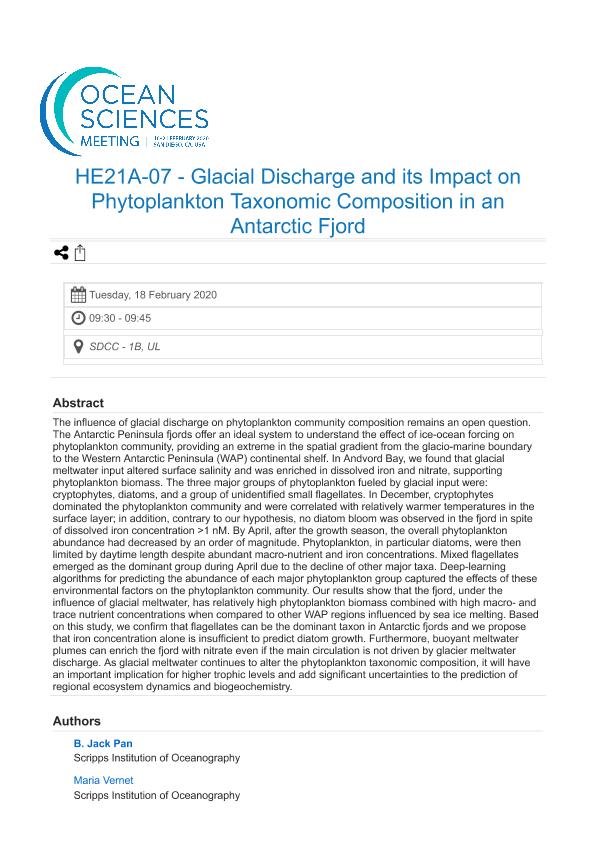Mostrar el registro sencillo del ítem
dc.contributor.author
Jack Pan, B.
dc.contributor.author
Vernet, Maria
dc.contributor.author
Manck, Lauren
dc.contributor.author
Forsch, Kiefer
dc.contributor.author
Ekern, Lindsey
dc.contributor.author
Mascioni, Martina

dc.contributor.author
Barbeau, Katherine
dc.contributor.author
Almandoz, Gaston Osvaldo

dc.contributor.author
Orona, Alexander James
dc.date.available
2022-04-12T15:53:35Z
dc.date.issued
2020
dc.identifier.citation
Glacial Discharge and its Impact on Phytoplankton Taxonomic Composition in an Antarctic Fjord; Ocean Sciences Meeting 2020; Estados Unidos; 2020; 1-3
dc.identifier.uri
http://hdl.handle.net/11336/155056
dc.description.abstract
The influence of glacial discharge on phytoplankton community composition remains an open question. The Antarctic Peninsula fjords offer an ideal system to understand the effect of ice-ocean forcing on phytoplankton community, providing an extreme in the spatial gradient from the glacio-marine boundary to the Western Antarctic Peninsula (WAP) continental shelf. In Andvord Bay, we found that glacial meltwater input altered surface salinity and was enriched in dissolved iron and nitrate, supporting phytoplankton biomass. The three major groups of phytoplankton fueled by glacial input were: cryptophytes, diatoms, and a group of unidentified small flagellates. In December, cryptophytes dominated the phytoplankton community and were correlated with relatively warmer temperatures in the surface layer; in addition, contrary to our hypothesis, no diatom bloom was observed in the fjord in spite of dissolved iron concentration >1 nM. By April, after the growth season, the overall phytoplankton abundance had decreased by an order of magnitude. Phytoplankton, in particular diatoms, were then limited by daytime length despite abundant macro-nutrient and iron concentrations. Mixed flagellates emerged as the dominant group during April due to the decline of other major taxa. Deep-learning algorithms for predicting the abundance of each major phytoplankton group captured the effects of these environmental factors on the phytoplankton community. Our results show that the fjord, under the influence of glacial meltwater, has relatively high phytoplankton biomass combined with high macro- and trace nutrient concentrations when compared to other WAP regions influenced by sea ice melting. Based on this study, we confirm that flagellates can be the dominant taxon in Antarctic fjords and we propose that iron concentration alone is insufficient to predict diatom growth. Furthermore, buoyant meltwater plumes can enrich the fjord with nitrate even if the main circulation is not driven by glacier meltwater discharge. As glacial meltwater continues to alter the phytoplankton taxonomic composition, it will have an important implication for higher trophic levels and add significant uncertainties to the prediction of regional ecosystem dynamics and biogeochemistry.
dc.format
application/pdf
dc.language.iso
eng
dc.publisher
American Geophysical Union
dc.rights
info:eu-repo/semantics/openAccess
dc.rights.uri
https://creativecommons.org/licenses/by-nc-sa/2.5/ar/
dc.subject
FJORD
dc.subject
ICE MELTING
dc.subject
PHYTOPLANKTON
dc.subject
PIGMENTS
dc.subject.classification
Biología Marina, Limnología

dc.subject.classification
Ciencias Biológicas

dc.subject.classification
CIENCIAS NATURALES Y EXACTAS

dc.title
Glacial Discharge and its Impact on Phytoplankton Taxonomic Composition in an Antarctic Fjord
dc.type
info:eu-repo/semantics/publishedVersion
dc.type
info:eu-repo/semantics/conferenceObject
dc.type
info:ar-repo/semantics/documento de conferencia
dc.date.updated
2022-03-16T20:14:29Z
dc.journal.pagination
1-3
dc.journal.pais
Estados Unidos

dc.journal.ciudad
San Diego
dc.description.fil
Fil: Jack Pan, B.. University of California at San Diego. Scripps Institution of Oceanography; Estados Unidos
dc.description.fil
Fil: Vernet, Maria. University of California at San Diego. Scripps Institution of Oceanography; Estados Unidos
dc.description.fil
Fil: Manck, Lauren. University of California at San Diego. Scripps Institution of Oceanography; Estados Unidos
dc.description.fil
Fil: Forsch, Kiefer. University of California at San Diego. Scripps Institution of Oceanography; Estados Unidos
dc.description.fil
Fil: Ekern, Lindsey. University of California at San Diego. Scripps Institution of Oceanography; Estados Unidos
dc.description.fil
Fil: Mascioni, Martina. Universidad Nacional de La Plata. Facultad de Ciencias Naturales y Museo. División Ficología; Argentina. Consejo Nacional de Investigaciones Científicas y Técnicas. Centro Científico Tecnológico Conicet - La Plata; Argentina
dc.description.fil
Fil: Barbeau, Katherine. University of California at San Diego. Scripps Institution of Oceanography; Estados Unidos
dc.description.fil
Fil: Almandoz, Gaston Osvaldo. Consejo Nacional de Investigaciones Científicas y Técnicas. Centro Científico Tecnológico Conicet - La Plata; Argentina. Universidad Nacional de La Plata. Facultad de Ciencias Naturales y Museo. División Ficología; Argentina
dc.description.fil
Fil: Orona, Alexander James. Ocean Motion Technologies; Estados Unidos
dc.relation.alternativeid
info:eu-repo/semantics/altIdentifier/url/https://agu.confex.com/agu/osm20/meetingapp.cgi/Paper/653344
dc.relation.alternativeid
info:eu-repo/semantics/altIdentifier/url/https://agu.confex.com/agu/osm20/meetingapp.cgi/Paper/653344
dc.conicet.rol
Autor

dc.conicet.rol
Autor

dc.conicet.rol
Autor

dc.conicet.rol
Autor

dc.conicet.rol
Autor

dc.conicet.rol
Autor

dc.conicet.rol
Autor

dc.conicet.rol
Autor

dc.conicet.rol
Autor

dc.coverage
Internacional
dc.type.subtype
Congreso
dc.description.nombreEvento
Ocean Sciences Meeting 2020
dc.date.evento
2020-02-18
dc.description.paisEvento
Estados Unidos

dc.type.publicacion
Book
dc.description.institucionOrganizadora
Ocean Sciences Meeting
dc.source.libro
Ocean Sciences Meeting Book of Abstracts
dc.date.eventoHasta
2020-02-21
dc.type
Congreso
Archivos asociados
